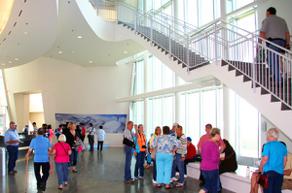About the Building
Museum Expansion - The Vision

Nationally recognized architect Joan Soranno and the GDM/HGA architectural team designed the building to convey a sense of Alaska, with innovative lines and spaces evoking images of alpine ridges, glaciers, breakup on the Yukon River and the aurora. The expanded museum building opened in 2005. As visitors arrive in Fairbanks by air, rail and road, they see this striking addition to the Fairbanks skyline, one of Alaska's major cultural landmarks.
Light filled spaces welcome and inspire scholars, visitors and staff with expansive windows that highlight the spectacular views of the Alaska Range, Denali and the Tanana River Valley. Inside, Alaska's treasures are protected and conserved - millions of biological, geological and cultural history specimens that tell our state's rich history and help us protect its health and well-being. Visitors to the University of Alaska Museum of the North will enjoy an experience not replicated elsewhere.
Public Spaces
Rose Berry Alaska Art Gallery

Just as the dramatic architecture of the museum conveys a sense of Alaska, the Rose Berry Alaska Art Gallery interprets art as an expression of the Alaska experience. Ancient ivory carvings, coiled grass baskets and other Alaska Native artworks will be featured side by side with historical and contemporary paintings and sculptures. Seattle-based Lehrman Cameron Studio's interior gallery design resonates with the building's architecture and provides a flexible space for the museum's collection and exhibit installation. The Rose Berry Alaska Art Gallery opened May 1, 2006
The Grand Lobby
The lobby is graced with magnificent architecture and the floating staircase next to the expansive two-story Alaska Range Viewing Window, which offers Fairbanks' best view of the Alaska Range and the Tanana Valley. In 2021, a 42-foot bowhead whale skeleton was added soaring above the lobby.
Collections Gallery
The museum offers a rotating display of exhibits, featuring a unique look at the research and cultural understanding supported by the artifacts, objects and specimens from the museum’s collections and elsewhere.
The Place Where You Go to Listen
An original and ever-changing sound and light environment composed by John Luther Adams, The Place Where You Go to Listen gives voice to the rhythms of daylight and darkness, the phases of the moon, the seismic vibrations of the earth and the activity of the aurora. "The Place" opened March 21, 2006.
Family Room
Located in the upper level above the Museum Store, this area gives visitors a place to relax and absorb their gallery experience. The family room is a place for children and adults to be curious. Collection-based touchable materials, toys, puzzles, and books encourage quiet investigation and intergenerational discovery time. The Family Room offers a low stress environment for adults to relax and all ages to explore.
Arnold Espe Multimedia Auditorium
The museum offers movies such as Dynamic Aurora in the 125-seat auditorium. The auditorium is also used for lectures, performances, and more. Retractable seating makes the auditorium a multi-purpose room that can be used for sit-down dinners, workshops and other events.
Museum Store
The Museum Store offers a wide variety of high quality artwork, jewelry and educational merchandise. All items relate to the museum's collections and all proceeds support the educational and research mission of the museum.
Coming Soon! Planetarium
Groundbreaking and construction will begin in summer 2024 for a planetarium attached to the west side of the museum. Learn more here.
Behind-the-Scenes
Creativity Lab & University Classroom

A K-12 classroom serves as a base of operations for docent-led school tours, family programs and other youth activities. The university classroom allows the museum's faculty curators to incorporate museum specimens into courses without taking the collections out of the museum's climate-controlled environment.
Research Collection Labs
State of the art research labs for each of the museum curatorial departments are a part of the collections work areas on the lower level. Cabinets and equipment in each lab are tailored to the department's unique needs.
Expanded Collections Range
The expanded area provides more space for the museum's growing collections of objects and specimens. Each collection has its own unique shelving arrangements. Compact mobile storage units expand collections space by approximately 30% by eliminating aisle walkways between each row. To protect the collections, strict temperature and humidity controls are maintained in the collections range.
Wet Collections Room
This specialized room with enhanced air exchange keeps biological specimens stored in alcohol separate from the rest of the museum's research collections. The shelving systems have been designed to protect the glass specimen containers in an earthquake. In the event that containers do fall on the floor and break, the alcohol will drain into a vault buried beneath the room.
Shared-Use Laboratories
Specimen Preparation Labs, located adjacent to the loading dock, give researchers work space for initial specimen processing. The Ancient DNA Lab enables researchers to extract minute quantities of ancient and degraded DNA from specimens without fear of contamination from other sources of DNA. Access is restricted to minimize incidental contamination. An Imaging Lab features microscopes linked to cameras, studio photography stations, and 3D scanning and printing equipment, making it possible for staff and students to capture digital images of objects from the museum's collections. The Molecular Lab is a shared facility for processing specimens for DNA analysis and setting up DNA amplification experiments.
